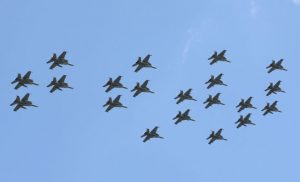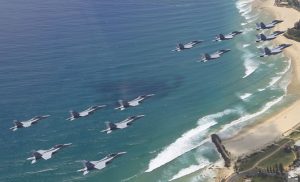
The final four aircraft of an order of 24 Boeing F/A-18F Super Hornets for the RAAF arrived at their Amberley home base west of Brisbane on Friday.
The four aircraft completed the final leg of their trans-Pacific delivery flight, which originated at Naval Air Station Lemoore in California on October 13. The aircraft were supported by a USAF KC-10 tanker for the journey, and stopped en route at Hickam AFB in Hawaii, Andersen AFB on Guam, and RAAF Base Townsville. For the final leg from Townsville to Amberley, Super Hornet A41-222 was piloted by Chief of Air Force AIRMSHL Geoff Brown, while A41-224 was piloted all the way from the US by the outgoing Officer Commanding 82 Wing, GPCAPT Steve Roberton, who was previously head of the Air Combat Transition office (ACTO) which managed the Super Hornet project from inception.
Before the four ship landed at Amberley, 16 other Super Hornets were launched to fly out and meet the final aircraft and escort them in, with the 20 aircraft performing a flypast of the Sunshine Coast, Brisbane and Ipswich.
They were welcomed to Amberley by Minister for Defence Materiel Jason Clare, president and chief executive officer of Boeing Defense, Space & Security Dennis Muilenberg, Ipswich Mayor Paul Pisasale, and other VIPs and guests.
“Boeing made a commitment to the Royal Australian Air Force, and to the citizens and government of Australia, promising that these advanced Super Hornets would be ready to join the RAAF fleet on time and on budget,” said Muilenburg. “The men and women of Boeing are incredibly proud to have delivered on that promise.”

Minister Clare said the Super Hornet would maintain Australia’s air combat capability until the arrival of the F-35 JSF later this decade. “The Super Hornet gives us the fire power we need to protect Australian skies until the arrival of the Joint Strike Fighter later this decade. Today we know that until that day comes we are in good hands.”
Clare also gave credit for the acquisition to former coalition Defence Minister Brendan Nelson. “I also pay credit to the former Minister for Defence Brendan Nelson who made the decision to buy these planes, when the success of today was not so easy to see,” he said. “The Super Hornets would not be in Australia if not for the decision that he made four-and-a-half years ago.”

Defence Minister Stephen Smith has not ruled out a further purchase of additional Super Hornets, but will wait until the tabling of the government’s Force Posture Review early next year, as well as various schedule and budgetry reviews into the JSF program currenty underway in the US.
















pez
says:great to see, wish I could have been there. VERY nice of him to mention Brendan Nelson. Great to see some politicians with an honest opinion, not just letting politics get in the way of a great day/event.
Eric Palmer
says:Great formation photo Andrew!
James
says:Great photos Andrew. The flyover was really something to see.
Louise
says:I was privileged to be there at RAAF Amberley yesterday – the flypast,the aerobatic dispaly, the noise, the excitement..This historic event was amazing!!
Col
says:And how much did this crap cost the Taxpayer?
Allan
says:Great to see the final four made it. Would love to have seen that mass flypast firsthand. Congratulations 82 wing and Air Combat Group.
Great photos Andrew, The spectacle must have been awesome.
Am most envious.
Cheers
australianaviation.com.au
says:Thanks Allan – it was certainly an awesome sight to see.
What was also awesome was the effort by 82WG staff to generate 23 jets for the day – one was in maintenance. There were the four new jets, the 16 that went out to meet them, the display jet, a display sparem and a formation spare. That’s huge considering the aircraft has only been in the inventory such a short time!
Pez – it was a classy call by Clare, who is generally seen as a bright talent and a great listener. Lets just hope he stays in the portfolio long enough to make a difference.
Cheers
Andrew
Ron
says:Well that didn’t seem to take long. Same re the C-17 program. Note to Government: Don’t buy planes that don’t exist!
Michael
says:These things have not the range, speed or payload of the aircraft they attempt to replace (F 111). Have a close look – you’ll probably never see one leave the deck without carrying external fuel. They were always a compromise design when the US Navy decided to get rid of its F 14 fleet and the designated successor didn’t arrive (looks like history may yet repeat itself with the F35). People will argue that the F-18 has a better avionics and radar fit out, and this may be true, but the fact is that it has built in permanent aerodynamic weaknesses. The F 111 could have accommodated a new radar, but there’s no way on Gods green Earth you’ll ever get the “Super” Hornet to go Mach 2.5. As to the supposed air-to-air capability – its a joke. Our classic Hornets are no longer competitive with the most advanced aircraft in the region, and these are slower and heavier. So why did we buy them? Because Andrew Peacock was Boeing’s salesman in Australia.
Peter
says:Michael – I absolutely agree the F/A-18 Super Hornet does not have a long range, speed and larger weapons payload. Which means two or more aircraft required to match range/payload of single F-111, F-15E or any high capability aircraft. The reason why Australia bought 24 F/A-18Fs is due to the delay of the F-35 JSF and the F-111s were considered too expensive to maintain due to the age of the airframe and the Super Hornet is used as an interim gap measure until the arrival of the JSF. I know what you mean the whole process is a complete joke. There was a roadmap upgrade program to the F-111 fleet back in 2001 which I’ve seen before.
The Super Hornet has the similar performance and capability deficiencies to the F-35 and is equally incapable of credibly performing against modern regional threats. The sting in the Super Hornets tail is not their, given its nickname the “Super Dog”. There’s no way the Super Dog can be expected to hold its own with the modern Russian/Chinese sourced fighters coming to into service now in our region. The F/A-18F is equipped with the APG-79 AESA which is a competitive design, however its key metric of detection range performance it has already been outclassed by the Tikhomirov NIIP Irbis-E (Snow Leapord) radar for the Su-35S/BM Flanker-E. Plus and available as an upgrade for the regional Su-30MKI and Su-30MKM Flanker-H.
The Su-35 has a huge 1-meter diameter radar bay which can accommodate the most powerful radar systems fitted to any combat aircraft. This will enable the Sukhoi pilot to detect and destroy partially stealthy aircraft such as the JSF. The performance increase in the Irbis-E is commensurate with the increasing transmitter rating, and NIIP claim a detection range for a closing 3 sq m coaltitude target of 190-215 nm (350-400 km), and an ability to detect a closing 0.01 sq m target at 50 nm (90 km). In track while scan (TWS) mode the radar can track 30 airborne targets simultaneously and provide guidance of two simultaneous shots using semi-active missiles e.g. AA-10 (R-27) Alamo family, or eight simultaneous shots using an active missile e.g. the AA-12 Adder (RVV-AE/R-77) or ramjet RVV-AE-PD/R-77M). This radar was clearly designed to support the ramjet RVV-AE-PD/R-77 missile in BVR combat against reduced signature western aircraft such as the F/A-18E/F Super Hornet Block 2 or Eurofighter Typhoon. NIIP does not claim superiority over the F-22As APG-77 AESA, yet their cited performance figures exceed the public (and no doubt heavilty sanitised) range figures for the APG-77. The Irbis-E radar has far greater detection range than the F-35s APG-81 AESA and far greater than the Super Hornets APG-79 radar and other small fighters radar at BVR detection range.
Check out this website Michael, you probably like the information about the weaknesses for the JSF and other aircraft options to cement the RAAFs regional air power lead at http://www.newaustralia.net/defence – Saving Billions on Air Forces.
Cheers
Peter
says:Andrew McLaughlin – Sorry to disappoint you if you’re reading my feedback. This is the time to give the anti-JSF supporters a fresh ammunition in their efforts to fight off the failed program. This is certainly a true statement what my friends and colleagues from defence aviation demonstrated the detailed modelling, analyst and participation in highly fidelity wargame simulation exercise which have shown that the JSFs have been defeated all realistic current and future threats that Australia is likely to face by the Sukhoi family and Chengdu J-20 Mighty Dragon. Part of the presentation showed a computer simulation which calculated that the F-35 would be consistently defeated by the Su-35 aircraft. The defeat calculated by the scenario also showed the loss of the F-35s supporting airborne-early warning and air-to-air refuelling tankers. The same goes for the stingless Super Dog (Super Hornet).
The T-50 PAK-FA 5th generation fighter now in development is expected to be much more lethal in air-to-air combat against the JSF. The Su-35 and PAK-FA made appearances this year at the Russian aerospace industry air show known as MAKS-2011. Both aircraft will include sensors and networking which can minimise the effects of limited low-observable qualities of the F-35. They will have higher performance, longer range (without refuelling), more powerful radars, advanced sensors, networking, data fusion capabilities and ability to carry more air-to-air and air-to-ground weapons than the JSF.
The F-35 JSF is undergoing a substantial flight test and evaluation program, which is not progressing well and not meeting test objectives. Myself and my colleagues have stated that what will be delivered (if F-35 ever arrives) will be obsolete, and that the F-35 will never be affordable or sustainable. With cost increases, schedule delays, and continuing technical problems also increases the risk that the program will not be able to deliver the aircraft quantities and capabilities in the time required by the warfighter. The F-35 has failed the initial stealth capability and remains behind schedule to provide the performance requirements. The cost of supporting the JSF will not progressively be refined until now and introduction into its service. The turkey (F-35) will be extremely costly to operate than the F-111, F/A-18 or other aircraft.
If you can’t see Australia rejecting our good relations with the US. Well if the JSF program continues to rise in cost etc etc and Boeing keeps the production for the Super Hornets (for Australia to buy more?) and does not deliver the capabilities as promised, I suggest Australia looks for other options on the table for the Sukhoi Su-35 Super Flanker, PAK-FA, or advanced F-15E+ or F-15SE for the RAAFs future fighter needs.
Cheers